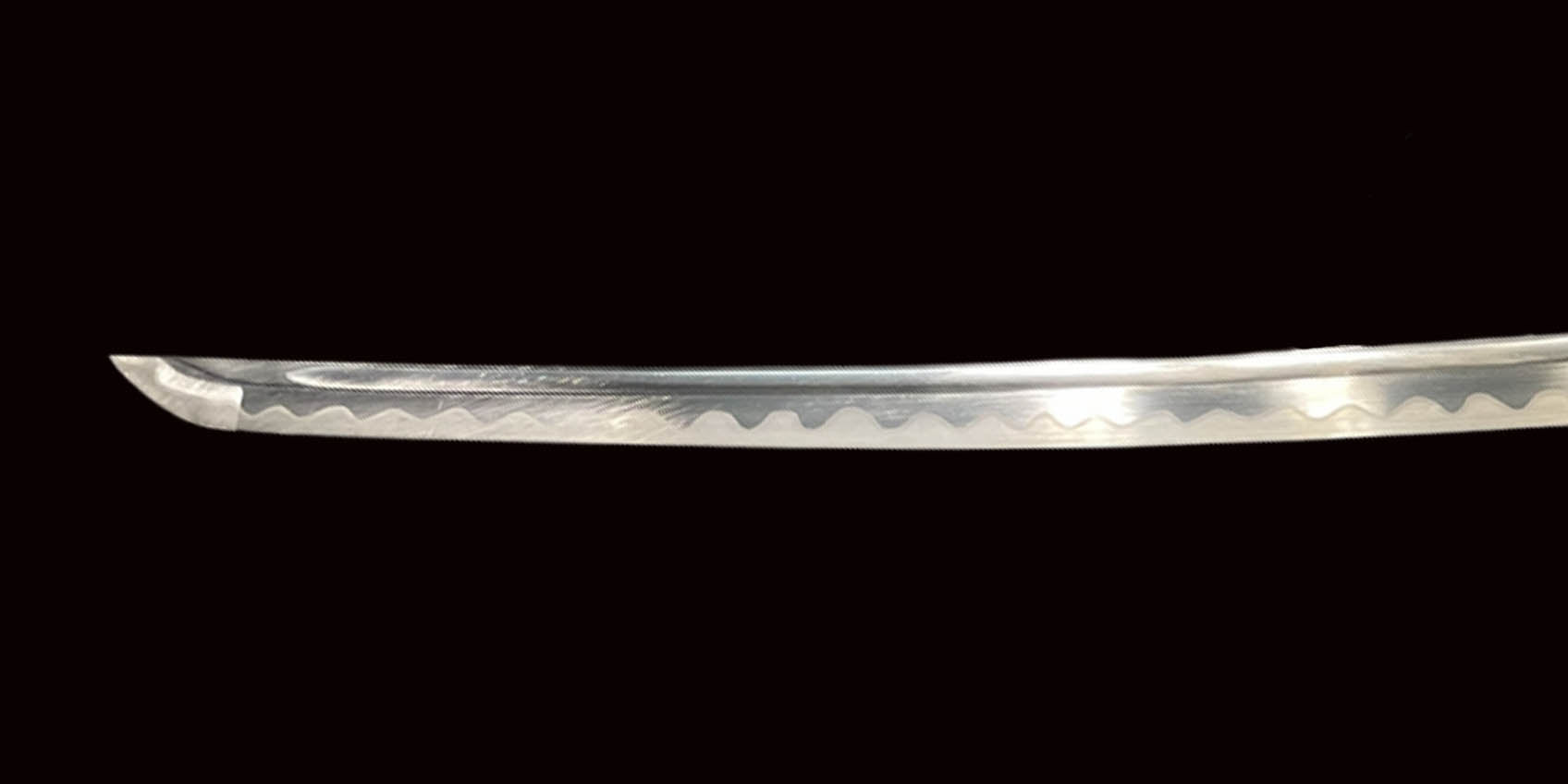Sharpened or Unsharpened Katana? Choosing the Right Samurai Sword

Can You Sharpen a Samurai Sword? Understanding the Difference Between Sharp and Unsharpened Blades
The samurai sword, as a symbol of traditional Japanese warrior culture, has long transcended the realm of cold weapons. It represents a unique combination of artistic craftsmanship, historical legacy, and the spirit of the samurai. More than just a deadly weapon, it is a work of art—every detail, from the forging of the blade and the variation of the hamon (temper line), to the decoration of the scabbard and handle, reflects the mastery and devotion of its maker. With its graceful curvature, balanced handling, and legendary sharpness that can 'cut through iron like mud,' the samurai sword has captivated collectors and practitioners worldwide.
Can a Samurai Sword Be Sharpened?
Yes, a samurai sword can be sharpened.
Traditionally, after a samurai sword is forged, it is sent to a professional polisher known as a 'togishi' for meticulous grinding and sharpening, ensuring the blade is razor-sharp. Even modern replicas or collector swords—if made from proper materials and with sound blade structure—can be sharpened.
When purchasing or using a samurai sword, whether the blade is sharpened or unsharpened is a crucial consideration. A sharpened blade is prized for its cutting power and is better suited for tameshigiri (cutting practice) or real-life applications. In contrast, an unsharpened blade emphasizes safety and aesthetics, ideal for display, ceremonies, or beginner training. These two types serve different functional purposes and are chosen based on the user’s needs and intended use.
That said, sharpening a samurai sword requires careful attention:
-
The blade material must be hard and tough enough—such as 1095 high carbon steel, T10 steel, or folded steel—to withstand grinding and cutting stress.
-
Sharpening must be performed with precision. Improper techniques can overheat the blade, cause edge chipping, or deform the shape.
-
For display or collection purposes, sharpening may not be necessary. But for practical use in cutting or martial training, a sharp edge is essential.
This article will explore in depth the concepts of sharpened and unsharpened samurai swords, their characteristics, differences, and how to choose the right one based on your goals.
What Is a Sharpened Samurai Sword?
A sharpened sword refers to a blade that has been precisely honed and polished to form a razor-sharp edge. This type of blade fully embodies the core functionality of a samurai sword—its superior cutting ability. A sharpened katana can easily slice through various materials such as bamboo or paper and even handle harder targets, demonstrating the legendary sharpness associated with the samurai sword.
This type of blade represents the pinnacle of both traditional swordsmithing and modern grinding techniques, seamlessly blending practicality with beauty.
Sharpened blades are commonly used in:
-
Martial arts practice and demonstrations
-
Professional cutting tests (tameshigiri)
-
Realistic combat simulation and training
Key Features of a Sharpened Blade:
-
Extremely Sharp: Crafted through a multi-step process involving grinding, polishing, and fine honing, the blade achieves a high level of cutting efficiency and precision.
-
Exceptional Cutting Performance: Suitable for real cutting tasks, martial arts displays, and testing, offering impressive slicing and penetrating power.
-
Complex Craftsmanship, Higher Maintenance: The sharp edge requires regular upkeep to remain effective and rust-free. Without care, it can dull or corrode.
-
Edge Vulnerability: The thinner edge can chip or crack upon contact with hard surfaces, so careful handling is essential to preserve its lifespan.
-
Functional and Artistic Value: A sharpened katana isn't just a weapon—it’s a testament to masterful craftsmanship, offering high aesthetic and collectible appeal.
How to sharpen a katana ?
Sharpening a katana requires professional tools and skills, typically using whetstones at a consistent 15 to 20-degree angle, alternating sides to gradually achieve a truly sharp edge. This process results in a real sharpened katana or real sharp katana that is suitable for battle-ready katanas. If you want to buy or experience one, you can find a katana nearby that is real katana made by hand with steel blade sharp, or choose from sharpened katanas for sale at shops offering fast katana delivery. These blades feature a cool blade design, not only ideal for collectors but also capable of impressive feats like cutting a katana in half, letting you truly feel the sharpness and power of this iconic weapon. Whether for practical use or display, a real sharp katana is the perfect choice for any sword enthusiast.
Sharpening a katana is a delicate art that depends heavily on the katana sword steel used. Among the types of Japanese swords, each blade’s steel quality influences how well it can hold and take a sharp edge. The best katana steel is often high carbon steel, but many appreciate folded steel katanas for their unique patterns and strength. While some blades use alternative materials like manganese steel, questions like is manganese steel good for swords arise, especially regarding sharpness and durability. Whether you have handmade katanas crafted with traditional techniques or custom katanas tailored to your preferences, proper sharpening ensures your blade achieves optimal cutting performance and longevity. A well-sharpened katana not only respects its craftsmanship but also unlocks its full potential as a true Japanese sword.
Who Should Choose a Sharpened Blade?
Sharpened swords are ideal for experienced martial artists, advanced practitioners, and collectors who seek an authentic cutting experience. Whether used in performance, cutting trials, or simulated combat, a sharpened blade showcases superior handling and power—perfect for those looking to elevate their swordsmanship.
What Is an Unsharpened Samurai Sword?
An unsharpened blade refers to a sword whose edge has not been honed into a sharp angle. The blade edge is typically blunt, rounded, or smooth—closely resembling a real sword in appearance but lacking cutting ability. In Japanese, these are often referred to as 'practice swords' or 'display swords.'
Unsharpened blades are widely used in:
-
Ceremonial displays
-
Stage performances
-
Martial arts training
-
Interior decoration and cultural exhibitions
These blades are designed to reduce the risk of injury while maintaining the beauty and structure of a real katana.
Key Features of an Unsharpened Blade:
-
Extremely Safe: The dull edge minimizes the risk of accidental cuts, making it suitable for beginners, youth, or public display settings.
-
Low Maintenance: Unlike sharpened blades, these require less upkeep since there's no sharp edge to preserve, reducing the risk of rust and damage.
-
Not Suitable for Cutting: While they look authentic, unsharpened blades cannot cut through any material and are not intended for real use.
-
Perfect for Training and Ceremonies: Used in Iaido, etiquette practice, Japanese cultural demonstrations, and beginner classes where safety and form matter more than function.
-
Budget-Friendly: Generally more affordable, making them an accessible choice for new enthusiasts or casual collectors.
Sharpened vs. Unsharpened: How to Choose
With so many types of samurai swords available, choosing between a sharpened and unsharpened blade comes down to your purpose and experience level.
| User Type | Recommended Blade | Reasoning |
|---|---|---|
| Collectors | Unsharpened | Safe and beautiful for long-term display and preservation |
| Beginner Practitioners | Unsharpened | Allows for safe training and movement practice |
| Advanced Martial Artists | Sharpened | Enables real cutting practice and full control development |
| Stage Performers | Depends on Use | Choose unsharpened for choreography; sharpened for cutting demonstrations |
| Ceremonial Participants | Unsharpened | Adheres to tradition, safe for rituals and formal events |
Conclusion
Whether you're drawn to the razor-sharp sharpened blade or the elegant and secure unsharpened blade, both are vital to the legacy of samurai sword culture. Sharpened blades offer a real-world cutting experience and martial value, while unsharpened blades emphasize cultural appreciation, safety, and formality. By understanding their differences and choosing based on your needs, you can more fully appreciate the depth and allure of Japanese sword heritage.
If you’re looking to purchase or learn more about high-quality samurai swords and custom engraving services, be sure to visit the [COOLKATANA Official Store], and begin your personal journey into the Way of the Sword.










